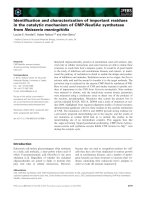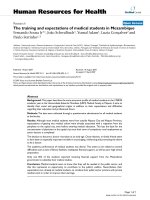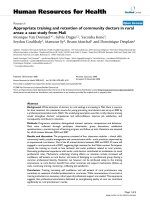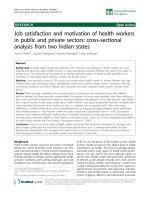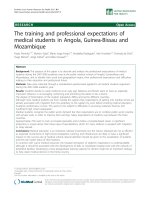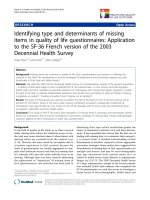báo cáo sinh học:" Appropriate training and retention of community doctors in rural areas: a case study from Mali" pdf
Bạn đang xem bản rút gọn của tài liệu. Xem và tải ngay bản đầy đủ của tài liệu tại đây (246.34 KB, 8 trang )
BioMed Central
Page 1 of 8
(page number not for citation purposes)
Human Resources for Health
Open Access
Research
Appropriate training and retention of community doctors in rural
areas: a case study from Mali
Monique Van Dormael*
1
, Sylvie Dugas
1,2
, Yacouba Kone
3
,
Seydou Coulibaly
3
, Mansour Sy
3
, Bruno Marchal
1
and Dominique Desplats
4
Address:
1
Institute of Tropical Medicine, Public Health Department, 155 Nationalestraat, 2000 Antwerp, Belgium,
2
Direction Départementale des
Affaires Sanitaires et Sociales, 2 boulevard Murat, BP 3840, 53030 Laval cédex 9, France,
3
Santé Sud, BPE686, Bamako, Mali and
4
Santé Sud, 200
Boulevard National, Le Gyptis, Batiment N, 13003 Marseille, France
Email: Monique Van Dormael* - ; Sylvie Dugas - ; Yacouba Kone - ;
Seydou Coulibaly - ; Mansour Sy - ; Bruno Marchal - ;
Dominique Desplats -
* Corresponding author
Abstract
Background: While attraction of doctors to rural settings is increasing in Mali, there is concern
for their retention. An orientation course for young practicing rural doctors was set up in 2003 by
a professional association and a NGO. The underlying assumption was that rurally relevant training
would strengthen doctors' competences and self-confidence, improve job satisfaction, and
consequently contribute to retention.
Methods: Programme evaluation distinguished trainees' opinions, competences and behaviour.
Data were collected through participant observation, group discussions, satisfaction
questionnaires, a monitoring tool of learning progress, and follow up visits. Retention was assessed
for all 65 trainees between 2003 and 2007.
Results and discussion: The programme consisted of four classroom modules – clinical skills,
community health, practice management and communication skills – and a practicum supervised by
an experienced rural doctor. Out of the 65 trained doctors between 2003 and 2007, 55 were still
engaged in rural practice end of 2007, suggesting high retention for the Malian context. Participants
viewed the training as crucial to face technical and social problems related to rural practice.
Discussing professional experience with senior rural doctors contributed to socialisation to novel
professional roles. Mechanisms underlying training effects on retention include increased self
confidence, self esteem as rural doctor, and sense of belonging to a professional group sharing a
common professional identity. Retention can however not be attributed solely to the training
intervention, as rural doctors benefit from other incentives and support mechanisms (follow up
visits, continuing training, mentoring ) affecting job satisfaction.
Conclusion: Training increasing self confidence and self esteem of rural practitioners may
contribute to retention of skilled professionals in rural areas. While reorientations of curricula in
training institutions are necessary, other types of professional support are needed. This experience
suggests that professional associations dedicated to strengthening quality of care can contribute
significantly to rural practitioners' morale.
Published: 18 November 2008
Human Resources for Health 2008, 6:25 doi:10.1186/1478-4491-6-25
Received: 22 January 2008
Accepted: 18 November 2008
This article is available from: />© 2008 Van Dormael et al; licensee BioMed Central Ltd.
This is an Open Access article distributed under the terms of the Creative Commons Attribution License ( />),
which permits unrestricted use, distribution, and reproduction in any medium, provided the original work is properly cited.
Human Resources for Health 2008, 6:25 />Page 2 of 8
(page number not for citation purposes)
Background
Staffing of health centres in rural and remote areas is a
problem all over the world, affecting particularly sub-
Saharan African countries [1-3]. In Mali, a country with
critical shortage of health professionals [4], overall availa-
bility of skilled health workers is improving, but urban/
rural disparities remain strong [5], and staff turnover is
high [6,7]. Most health centres in Mali are headed by a
nurse, though medical doctors increasingly engage in first
line practice, including in rural and remote areas [8-10].
While attraction of rural doctors is steadily rising, there is
concern about their long-term retention. In response, an
orientation course for recently established rural doctors
was set up in 2003, based on a training needs assessment.
This paper draws lessons from this experience, focusing
on processes and mechanisms operating in the relation
between training and retention in rural practice.
Determinants of staff turnover in rural and remote areas
It is widely recognised that qualified staff turnover tends
to be more acute in rural and remote areas than in urban
settings [11-13]. This may affect quality of service provi-
sion, as new comers need time to establish a relationship
with the community. High turnover also affects health
service efficiency and team productivity during the initia-
tion period of the newcomer [11]. Turnover may also
result in prolonged periods of understaffing of health
facilities.
While there is considerable overlap between factors affect-
ing attraction and retention in rural areas, attraction is
based on expectations while retention is based on actual
working and living experience [14]. Turnover is partially a
result of job dissatisfaction, which induces not only de-
motivation and absenteeism, but also intentions to quit
[11,15].
Job satisfaction, and consequently willingness to remain
in a rural post, is influenced by a complex interplay
between individual factors, living environment and work-
ing conditions [2,16]. Individual professionals have dif-
ferent backgrounds and expectations, but also vary in
terms of self-confidence, which impinge on job satisfac-
tion: people with higher self confidence are more likely to
persist longer at the task in the face of obstacles than peo-
ple with lower self-confidence [16].
Living environment has strong influence on job satisfac-
tion in rural areas: inadequate housing, lack of schools
and lack of recreational facilities are push factors inducing
staff to leave [2,17]. The quality of relations with patients
and recognition by local community are all the more
essential in rural practice since opportunities to develop
alternative social networks are limited [18].
Last but not least, working conditions are major determi-
nants of job satisfaction, According to Herzberg's motiva-
tional theory [19], factors that make people dissatisfied at
work are different from those motivating them to do a
good job. Dissatisfiers relate to working conditions rather
than the task itself: low salary, poor career perspectives
and training opportunities, unsatisfactory access to sup-
plies and support mechanisms, and disappointing human
interactions with colleagues and managers all contribute
to a sense of dissatisfaction. In contrast to these extrinsic
motivational factors, intrinsic motivation relates to the
actual content of work, feelings of achievement, self
esteem and self confidence; they contribute to job satisfac-
tion and stimulate performance. According to Herzberg,
limiting dissatisfiers motivates a worker to stay, but not to
perform better. In line with this theory, some authors
argue that avoiding dissatisfiers is more important to pro-
mote retention than building particularly high levels of
job satisfaction [20]. Others however challenge this view,
especially for professionals, and suggest that turnover
results as much from low intrinsic job satisfaction than
from experiencing difficult working environments [21].
The Malian Rural Doctors Movement
In 2007, 99 rural doctors were serving in over 13% of
Mali's rural community health centres [8]. Explanations
of this attraction of doctors into rural first line practice –
unusual in Sub Saharan Africa – lie in Mali's health sector
reform and health labour market evolution, as well as in
an incentive package easing recruitment.
A peculiarity of Malian health sector reform in the 1990s
was the development of a network of community health
centres managed by locally elected community health
associations, in charge of contracting and paying staff.
Over the years, community demand for doctors increased.
The allocation of Heavily Indebted Poor Countries
(HIPC) funds to recruit health staff for rural and remote
health areas reduced the financial burden on communi-
ties and has accelerated the process since 2001.
In the meantime, the production of medical doctors rose
dramatically, from 50 graduates a year in 1998 to 350 in
2006 [22]. Job opportunities for young doctors in Mali,
however, have not increased proportionally: public sector
recruitment remains restricted, the private sector in
Bamako is reaching saturation, opportunities for speciali-
sation are scarce, international brain drain is negligible,
and NGOs recruit experienced doctors.
But rural practice is not necessarily a default choice, as
teachers from the Faculty of Medicine encourage students
to settle in remote areas. Rural practice is also promoted
through a package of non-financial incentives provided by
an NGO (Santé Sud) and the Malian Rural Doctors Asso-
Human Resources for Health 2008, 6:25 />Page 3 of 8
(page number not for citation purposes)
ciation (Association des Médecins de Campagne): young
doctors settling in rural areas usually benefit from inter-
ventions aiming at improving living conditions (water,
solar panels, motorbike) and working conditions (basic
equipment, continuous education, peer support and men-
toring). There also is a consensus that financial prospects
in rural practice are quite acceptable, except in areas with
very low population densities. Indeed, rural doctors are
usually paid a basic salary, complemented with bonuses
proportional to their workload.
Retention of newly recruited community doctors is how-
ever not automatic. Anecdotal observation suggests that
they face unforeseen situations for which they feel ill pre-
pared, leading sometimes to early dropout [23]. In
response, the NGO and the Rural Doctors Association
decided to set up an orientation course for recently estab-
lished rural doctors. The underlying assumption was that
training meeting rural practitioners' needs would
strengthen young doctors' technical competences and self-
confidence, and consequently contribute to retention.
In this paper, we present the findings of an evaluation of
this training course, which addressed the following
research questions: (1) What are unmet training needs for
rural general practitioners in Mali, (2) What were effects of
the orientation course on trainees, and (3) Did the course
affect retention, and if so, how?
Methods
The design and implementation of the training pro-
gramme was conceived as a participatory action research
process, aiming at finding solutions to a practical prob-
lem, while generating knowledge to share with a wider
audience [24,25]. Unmet training needs were assessed
through group discussions with senior rural practitioners,
exploring their own difficulties in fulfilling different func-
tions of a rural doctor: clinician, public health practitioner
in charge of a community, health centre manager, and – a
cross-cutting function – communicator [23]. On this
basis, a training programme was designed, consisting of
class modules combined with a practicum in a rural
health centre run by a senior doctor. Senior doctors
involved in the training were appointed by the profes-
sional association; selection criteria included peer recog-
nition for excellence, at least 4 years experience in a wide
scope of clinical and community-based activities, and
good integration in their community and local health sys-
tem.
In order to assess the effects of the course, we used Kirk-
patrick's model of evaluation [26] distinguishing four lev-
els:
• level 1 assesses trainees' reactions, satisfaction and per-
ceived relevance to their work
• level 2 assesses trainees' learning and changes in knowl-
edge, skills and attitudes
• level 3 assesses whether the training changed actual
behaviour on the job
• level 4 assesses overall results in terms of production
and performance.
This evaluation focused on the three first levels. Reactions
(level 1) were assessed by open ended satisfaction ques-
tionnaires, eliciting participants' appraisals about the
training and its relevance to practice. This was comple-
mented by participant observation and recording of com-
ments during the training sessions, aiming at validating
and refining the initial training needs assessment. In order
to assess level 2, a reference tool was designed for the
practicum, enabling the trainee and his supervisor to
define priority learning objectives and assess learning
progress; for evaluation of classroom modules, no system-
atic tests were conducted before and after the sessions, but
role plays and supervised exercises were used to monitor
learning progress. Finally, effects on actual practice (level
3) were assessed by the NGO coordinators through two
follow up visits to each trainee within the year following
the training. These visits were primarily meant as support-
ive supervisions, but also contributed to identify to what
extent training contents were implemented in practice; an
indicative checklist was designed, including indicators
related to quality and affordability of clinical care, com-
munity health activities, practice management, team lead-
ership, and interactions with district authorities and
hospital.
Finally, we measured retention by assessing the profes-
sional career of all doctors who participated in the train-
ing from 2003 to 2007. Baseline data of retention of rural
doctors prior to the introduction of the programme could,
however, not be retrieved.
Results
Training needs and programme design
Analysis of the training needs assessment resulted in three
main categories: (1) skills and competencies poorly
addressed during medical training, including health-cen-
tre management, community health programmes, and
communication and conflict management; (2) specific
clinical skills and knowledge adapted to remote and iso-
lated practice conditions; (3) socialisation to the rural
doctor's professional role, and internalisation of norms,
values, and practical attitudes characterising rural practice.
Human Resources for Health 2008, 6:25 />Page 4 of 8
(page number not for citation purposes)
On this basis, a yearly training session was organised,
starting in 2003, for 10 to 16 recently installed rural doc-
tors, comprising four weeks classroom teaching and four
weeks practicum in a health centre run by an experienced
rural doctor. The classroom modules addressed clinical
skills, health-centre management skills, public health,
and communication skills (see Table 1). To stimulate
reflection on experience rather than mere knowledge
transmission, an interactive pedagogic approach was
applied. Each module was prepared and conducted jointly
by a "topic expert" (with academic, MOH or NGO back-
ground) and a "profession expert" (an experienced com-
munity doctor). The involvement of senior doctors in the
implementation of modules aimed at taking advantage of
their field experience and at providing role models. It was
also meant to ensure alignment between classroom ses-
sions and practicum. The four weeks of classroom ses-
sions ended with a global evaluation and a final assembly
where experienced community doctors offered final rec-
ommendations to the trainees. Skills learned during the
modules were implemented during the practicum, under
supervision of a senior doctor, individual priority needs
being defined jointly by the trainee and his supervisor.
Assessment of the training programme
Trainees' satisfaction and perceived relevance of the
course for the problems they encountered in practice
(Kirkpatrick's level 1) was high.
Participants expressed at the beginning of the modules a
lack of self-confidence, exacerbated by their social and
professional isolation. Not only did they feel unprepared
to carry out their clinical duties with limited technical
equipment and referral opportunities, but most had not
anticipated the cultural gap they experienced when join-
ing their rural post. They reported frequent relational
problems detrimental to their social integration: conflicts
with the health centre committee (their employer) about
working conditions and financial management issues,
leadership conflicts with other staff members, absentee-
ism and misbehaviour of staff, tense coexistence with tra-
ditional practitioners, or disagreements with the district
medical officer concerning boundaries between first line
care and hospital care. They also wanted advice on how to
develop trust relationships with the community, and
expressed strong feelings of powerlessness in changing
health behaviours they considered harmful.
Both the questionnaire responses and the final evaluation
session indicated a high level of satisfaction regarding the
training. Though they expressed a high demand for fur-
ther training, in particular in clinical issues, participants
described the course as crucial for increasing their self-
confidence. A few explicitly stated that it had convinced
them to continue practicing in rural areas. Trainees appre-
ciated the interactive pedagogic approach inviting them to
reflect on their own experience. They also welcomed the
technical inputs, some of which were totally new to most
trainees (for instance practice management, or interpreta-
tion of routine indicators for self evaluation). Besides
technical inputs, young doctors unanimously valued shar-
ing and discussing professional experience with elder
practitioners. They were eager to discuss ways of thinking
and behaving as a rural community doctor, and senior
doctors were eager to share experience. Many problem
issues raised during these discussions were related to
human relations with the community and at workplace:
finding a balance between distance and proximity with
community members, acknowledging social hierarchies
while remaining equitable, controlling staff behaviour
without crystallizing antagonisms from staff and/or com-
munity members. Such problems were exacerbated in
rural areas, where any work related dispute easily becomes
a broader community dispute affecting doctors' social
integration, as many staff members are from surrounding
community. The final session of recommendations by
experienced doctors, illustrated in table 2, provided fur-
ther opportunities to reflect on professional ethos and to
strengthen feelings of shared professional identity and
belonging to a group. Senior doctors contributed substan-
tially to an accelerated professional socialisation process,
which proved to be a more important training need than
anticipated. It should also be noted that several senior
doctors declared that, if they had had access to such a
Table 1: Objectives and contents of the four training modules
Clinical skills: the purpose was not to update clinical competencies, but rather to strengthen decision making capacity in remote contexts,
characterised by limited equipment and referral opportunities; the module meant also to address continuity of care and patient-centeredness as
characteristics of first line care.
Practice management: the module aimed at making participants acquainted with Malian laws and regulations related to health centre functioning,
and with practical skills and tools related to financial management, human resource management, and drug management at health centre level.
Public health: the module aimed at strengthening abilities to deal with community health issues by articulating curative, preventive and
promotional care, using the existing information system for self-evaluation and local planning, establishing dialogue with the community; a second
objective was to increase participants' awareness of the role of first line and its relations with other actors within the Malian health care system.
Communication skills: the objective was to improve rural doctors' communication skills by making them reflect on their own communication
style, and by increasing their awareness of the gaps between their own views and the views of the different actors with whom they interact:
patients, communities and their representatives, staff members, local authorities, district health authorities Topics included health and health
seeking behaviour, patient-doctor communication, health education and teamwork
Human Resources for Health 2008, 6:25 />Page 5 of 8
(page number not for citation purposes)
training, this would have prevented them from making
errors when they first started work.
While there is strong evidence about participants' satisfac-
tion and perceived relevance of the process and content of
training, results related to changes in knowledge and skills
(Kirkpatrick level 2) are less conclusive: the tool meant to
evaluate learning during practicums was felt as too
demanding and was not systematically applied. Informal
feed back from teachers and supervisors suggests that
skills were acquired, but more detailed information is
missing.
Finally, follow up visits by Santé-Sud NGO coordinators
confirmed increased self confidence of trainees. It was dif-
ficult to assess the extent of actual behavioural changes
(Kirkpatrick Level 3) as no baseline data were available.
Supervisors' observations suggest overall good levels of
team leadership and interactions with district authorities,
but persisting difficulties, for part of the trainees, in mas-
tering practice management, developing strategic plans
and implementing community based health promotion
activities.
Retention of trained doctors
Between 2003 and 2007, 65 newly installed rural doctors,
deployed in all regions of the country, participated in the
training. Table 3 shows yearly cohorts and retention in
rural practice over the years. At the end of 2007, 55 out of
the 65 trained young doctors (85%) were still engaged in
rural practice. A few had moved to another rural health
centre. The timeframe regarding retention is rather short,
as about half of the trainees had less than two years prac-
tice at the end of 2007. When focusing on the three first
cohorts trained in the period 2003 to 2005, for which we
have longer retrospective data, respectively 50%, 77% and
86% were still in rural practice 4, 3 and 2 years after the
training. Eight out of 32 trainees for this period were no
longer in rural practice end of 2007; five of them left
within the two first years of installation. The 8 "dropouts"
went for specialist training, got involved in a private prac-
tice in the capital city Bamako, or were hired by an NGO.
Discussion
Our hypothesis was that appropriate training would
strengthen young doctors' competence and self-confi-
dence, and consequently contribute to retention.
Though we lack baseline data, our study suggests that
retention of trained rural doctors is relatively high for the
Malian context. In 2005, only 21% of the heads of health
centres in Mali had been in post for 3 years or more, 29%
between 2 and 3 years, and 49% less than 2 years. (Ronse,
I. personal communication based on PRODESS monitor-
ing tools, 17/2/2008); these data include urban health
centres, where turnover is usually lower [11,12]. Mahe et
al [27] found that half of the health workers of 20 Malian
health centres trained in 2001 had been replaced by new
health workers after 18 months. Similarly, a study con-
ducted in 1997 in 41 community health centres showed
that only 29% of the heads of health centres had been
working in their settings for more than 2 years [28]. By
Table 2: Examples of recommendations by senior community doctors to young trainees
• « Avoid favouritism. The chief of the village should queue like any other villager »
• « Never tell a patient that what he is doing is wrong, he wouldn't come back »
• « Respect customs, don't say they are harmful, rather explain that there are other methods »
• « Remain neutral, never take sides with one group of the community against another »
• « Recognise staff members' achievements, and punish misbehaviour: making regulations explicit protects staff members from social pressure from
their relatives »
• « Don't monopolise the floor during meetings with the health centre committee; listen to them and give them the opportunity to explain their
views »
• « Being a rural doctor requires courage »
Table 3: Number of newly installed trained doctors and retention in rural practice (2003–2007)
Number of newly installed doctors trained Number of doctors still in rural practice end
2007
Number of early dropouts
(less than 2 years rural practice)
2003 8 4 (50%) 1
2004 9 7 (77%) 0
2005 15 13 (86%) 2
2006 16 13 (81%) 3
2007 17 17 (100%) -
Total 65 55 (85%) 5
Source: Santé Sud
Human Resources for Health 2008, 6:25 />Page 6 of 8
(page number not for citation purposes)
contrast, our three first cohorts of trainees showed 50%
retention after 4 years, 77% after 3 years, and 86% after 2
years.
We cannot conclude, however, that training was the main
determinant of retention. First, incentives related to living
and working conditions, which influenced rural doctors'
attraction, also contribute to retention. Second, other sup-
port mechanisms known to foster retention [2,15,29] are
provided: mentoring, supervision, and access to further
rurally relevant continuous training sessions. While com-
plementary bundles of interventions indeed work better
than isolated interventions [30], it is difficult to disentan-
gle their effects.
Our initial hypothesis was that training would increase
feelings of being able to do the job. Data concerning reac-
tions of participants (level 1) confirm increased self confi-
dence and high satisfaction with the programme, and
suggest that it was indeed appropriately responding to
training needs. But methodological weaknesses in assess-
ing changes in competence (level 2) and performance
(level 3), prevent us from concluding that self confidence
results indeed from superior skills and knowledge. On the
basis of follow up visits, we may however assume that the
training raised awareness about different roles of rural
practitioners, and provided information and technical
tools useful for carrying out their novel functions. Part of
the training dealt with relatively simple practical issues
likely to affect working conditions and job satisfaction:
good drug management avoids shortages and subsequent
frustrations; tools for transparent financial management
prevent conflicts with health centre committee; clarifica-
tion of regulations limits misunderstandings with public
authorities.
Participant observation of the experience allows us to
hypothesise two further mechanisms operating in the
relation between this continuous training experience and
retention.
First, the course not only addressed knowledge and skills,
but also professional socialisation, i.e. "the learning of
attitudes, norms, self images, values, beliefs and behav-
ioural patterns" associated with professional practice [31].
Group discussions contributed to internalisation of ways
of thinking, feeling and acting as a rural doctor. The crys-
tallisation of rural doctors' professional identity during
this process fostered self-esteem: rural practice was por-
trayed as a demanding profession of high added social
value, but also a rewarding profession, as rural doctors
provide a wide range of comprehensive care and have a
high level of autonomy. This socialisation process
resulted from the method as much as the content of train-
ing, addressing a homogeneous group of rural doctors,
involving senior doctors as role models, and emphasising
group work and experience sharing.
Second, appropriate continuous training for rural practice
contributes to retention also by alleviating feelings of pro-
fessional isolation [32]. The training process of Malian
rural doctors had a strong supporting function, strength-
ening their sense of belonging to a group and their ability
to resist social and professional isolation. It should be
noted that the course turned out to be an intense moment
in the professional association's life, contributing to the
establishment of lasting supportive relationships with
peers and mentors, which probably enhanced job satisfac-
tion.
The experience highlights the importance of intrinsic sat-
isfaction for retention: improved retention was not only
the consequence of diminishing dissatisfiers, it also
resulted from self esteem as a rural practitioner, helping to
resist dissatisfiers. In this project, clarifying a sense of mis-
sion and professional ethos was facilitated by a profes-
sional association. A mission oriented organisational
culture initiated through other means could achieve simi-
lar effects on retention.
The underlying mechanisms – i.e. increasing self confi-
dence in own skills, self esteem as rural doctor, and sense
of solidarity within a group sharing a common profes-
sional identity – need to be framed in the specific Malian
context. Indeed, the training course had the effects dis-
cussed above, because the graduates of medical school are
not enabled to fully function in posts at the first line in
rural areas. This type of course, therefore, will be more
effective in settings where medical education is oriented
towards hospital or district-level medicine, and where
rural practice entails novel professional roles for medical
doctors [33].
Policy implications
As the training consists to a large extent in compensating
for shortcomings of the medical school-based training, a
reasonable approach would be to incorporate this kind of
training in the basic curriculum. Though highly desirable,
this is but a first step. Medical school can, and should,
address training needs pertaining to clinical skills, rational
use of technical procedures, community health, practice
management and communication, which are indeed use-
ful in any situation. Socialisation to rural practice could
also be developed through specific rural practice pro-
grammes.
However, once installed, rural doctors face challenging
situations and are in need for peer-based reflection and
support, especially when they start with rural practice and
are at highest risk of encountering discouraging critical
Human Resources for Health 2008, 6:25 />Page 7 of 8
(page number not for citation purposes)
incidents. Even if at academic level, the medical curricu-
lum was revised to improve alignment with practice, there
would still be a need for structured professional support.
In the project discussed here, this is ensured through a
package consisting of continuous training, mentoring,
supportive supervision and regular meetings, all provided
within a professional association with support from an
NGO. Such a package, more than the training alone, is
likely to promote retention, at least during a few years.
Conclusion
While incentive packages condition acceptance to work in
rural and remote areas, self confidence and self esteem
affect decisions to remain in these posts. Appropriate
training can contribute to retention by improving skills,
changing attitudes and enhancing self confidence. Other
support mechanisms are however necessary to help prac-
titioners to cope with social and professional isolation.
The Malian Rural Doctors experience suggests that a pro-
fessional association, dedicated to strengthening quality
of care, can contribute significantly to rural practitioners'
morale.
Competing interests
The authors declare that they have no competing interests.
Authors' contributions
MVD and SD both contributed to the design, implemen-
tation and evaluation of the programme and drafted the
manuscript. YK carried out the preliminary analysis of
training needs, contributed to the design, implementation
and evaluation of the programme and revised the manu-
script. SC and MS contributed to the design, implementa-
tion and evaluation of the programme, collected follow
up information about trainees and revised the manu-
script. BM drafted and revised the manuscript. DD con-
tributed to the design and evaluation of the programme
and revised the manuscript.
Acknowledgements
We wish to acknowledge the contributions of Thimothée Dao, Seydou
Konate and Moussa Mariko, who actively participated to the design and
implementation of the intervention as senior rural doctors. We also wish
to acknowledge the contribution of Mahamadou Thiero from Santé Sud,
who contributed substantially to the design and teaching of the practice
management module.
The intervention was funded by Santé Sud, with complementary financial
support from the European Union. The technical support provided by the
Institute of Tropical Medicine was financed by the Belgian Cooperation.
None of these funding agencies influenced the intervention or its analysis.
References
1. Dussault G, Franceschini MC: Not enough there, too many here:
understanding geographical imbalances in the distribution of
the health workforce. Hum Resour Health 2006, 4:12.
2. Lehmann U, Dieleman M, Martineau T: Staffing remote rural
areas in middle- and low-income countries: a literature
review of attraction and retention. BMC Health Serv Res 2008,
8:19.
3. Rabinowitz HK, Diamond JJ, Markham FW, Paynter NP: Critical fac-
tors for designing programs to increase the supply and
retention of rural primary care physicians. Jama 2001,
286:1041-8.
4. WHO: World Health Report, Geneva; 2006.
5. Ministère de la Santé du Mali, Direction Nationale de la Santé: Rapport
Bilan Année 2005, Comité Technique du PRODESS, Bamako 2006.
6. Audibert M, de Roodenbeke E: Utilisation des services de santé
de premier niveau au Mali: analyse de la situation et perspec-
tives. Banque Mondiale, Région Afrique, Département du Développement
Humain 2005.
7. Fournier P, Dufresne C, Zunzunegi MV, Haddad S: Réformes des
systèmes de santé et satisfaction du personnel: le cas du
Mali. Proceedings CERDI: 2ème colloque international "Financement de la
Santé dans les Pays en Développement, Clermont-Ferrand 1 December
2005 .
8. Coulibaly S, Desplats D, Kone Y, Nimaga K, Dugas S, Farnarier G, Sy
M, Balique H, Doumbo OK, van Dormael M: Une médecine rurale
de proximité: l'expérience des médecins de campagne au
Mali. Educ Health 2007, 20:47.
9. Dugas S, van Dormael M: La construction de la médecine de
famille dans les pays en développement. In Studies in Health
Services Organisation and Policy 22 ITG Press, Antwerp; 2003.
10. Desplats D, Kone Y, Razakarison C: Pour une médecine générale
communautaire en première ligne. Médecine Tropicale 2004,
64:539-544.
11. Zurn P, Dolea C, Stilwell B: Nurse retention and recruitment:
developing a motivated workforce. In The Global Nursing Review
Initiative International Council of Nurses, Geneva; 2005.
12. Thommasen HV: Physician retention and recruitment outside
urban British Columbia. British Columbia Medical Journal 2000,
42:304-308.
13. Eley D, Young L, Shrapnel M, Wilkinson D, Baker P, Hegney D: Med-
ical students and rural general practitioners: congruent
views on the reality of recruitment into rural medicine. Aust
J Rural Health 2007, 15:12-20.
14. Bilodeau H, Leduc N: Recension des principaux facteurs
d'attraction, d'installation et de maintien des médecins en
régions éloignées. Cah Sociol Demogr Med 2003, 43:485-504.
15. Clarke HF, Laschinger HS, Giovannetti P, Shamian J, Thomson D,
Tourangeau A: Nursing shortages: workplace environments
are essential to the solution. Hosp Q 2001, 4:50-7.
16. Franco L, Bennett S, Kanfer R: Health sector reform and public
sector health worker motivation: a conceptual framework.
Soc Sci Med 2002, 54:1255-1266.
17. Kotzee TJ, Couper ID: What interventions do South African
qualified doctors think will retain them in rural hospitals of
the Limpopo province of South Africa? Rural Remote Health
2006, 6:581.
18. Dieleman M, Cuong PV, Anh LV, Martineau T: Identifying factors
for job motivation of rural health workers in North Viet
Nam. Hum Resour Health 2003, 1:10.
19. Herzberg F: One more time: How do you motivate employ-
ees? Motivating people. Best of HBR. Harvard Business Review 2002.
20. Pathman DE, Konrad TR, Williams ES, Scheckler WE, Linzer M, Doug-
las J: Physician Job satisfaction, job dissatisfaction, and physi-
cian turnover. J Fam Pract 2002, 51(7):593.
21. Ullrich RA: Herzberg revisited: factors in job dissatisfaction. J
Nurs Adm 1978, 8(10):19-24.
22. Thiero M: Surproduction des médecins au Mali: une opportu-
nité pour renforcer la première ligne. In Master thesis in public
health Institute Tropical Medicine, Anwerp; 2007.
23. Kone Y: Adéquation entre la formation initiale et la fonction
de médecin généraliste au Mali. In Master thesis in public health
Institute Tropical Medicine, Antwerp; 2003.
24. Meyer J: Qualitative research in health care. Using qualitative
methods in health related action research. BMJ 2000,
320:178-181.
25. Grodos D, Mercenier P: Health systems research: a clearer
methodology for more effective action. In Studies in Health Serv-
ice Organisation and Policy 15 ITG Press, Antwerp; 2000.
26. Kirkpatrick DL: Evaluating training programs: the four levels.
Berrett-Koehler Publications, San Francisco; 1998.
Publish with Bio Med Central and every
scientist can read your work free of charge
"BioMed Central will be the most significant development for
disseminating the results of biomedical research in our lifetime."
Sir Paul Nurse, Cancer Research UK
Your research papers will be:
available free of charge to the entire biomedical community
peer reviewed and published immediately upon acceptance
cited in PubMed and archived on PubMed Central
yours — you keep the copyright
Submit your manuscript here:
/>BioMedcentral
Human Resources for Health 2008, 6:25 />Page 8 of 8
(page number not for citation purposes)
27. Mahe A, Faye O, N'diaye HT, Konare HD, Coulibaly I, Keita S, Traore
AK, Hay RJ: Integration of basic dermatological care into pri-
mary health care services in Mali. Bull World Health Organ 2005,
83:935-941.
28. Population Council: Etude des CSCom et CSAR dans le cadre de l'implan-
tation du programme national de distribution à base communautaire en SE/
PF dans les aires opérationnelles des Regions de Kayes, Koulikoro, Sikasso,
Segou et Mopti. Bamako 1998.
29. Mathauer I, Imhoff I: Health worker motivation in Africa: the
role of non-financial incentives and human resource manage-
ment tools. Hum Resour Health 2006, 4:24.
30. Marchal B, Kegels G: Focusing on the software of managing
health workers: What can we learn from high commitment
management practices? Int J Health Plann Manage. 2008,
23:299-311.
31. Fox RC: The sociology of medicine. A participant observer's view Prentice
Hall. Foundations of Modern Sociology Series. Englewood Cliffs, New
Jersey; 1989.
32. White CD, Willett K, Mitchell C, Constantine S: Making a differ-
ence: education and training retains and supports rural and
remote doctors in Queensland. Rural Remote Health 2007, 7:700.
33. Van Dormael M, Dugas S, Diarra S: North-South exchange and
professional development: experience from Mali and France.
Fam Pract 2007, 24:102-107.

